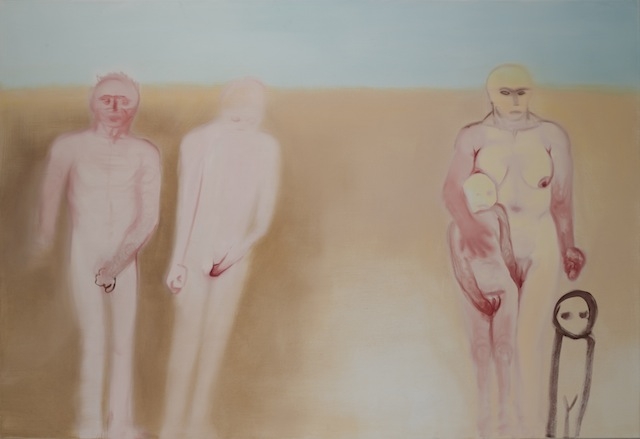Galerie Jocelyn Wolff, Paris 29 April – 17 June
Upon entering devoir-aimer (literally ‘must-love’), Miriam Cahn’s fourth solo show at Jocelyn Wolff, I was immediately struck by unklar(7.7.16) (2016), one of seven recent oil paintings displayed alongside a selection of pastel, chalk and charcoal drawings. This half-length portrait represents a human-size naked female figure standing against the murk of a rapidly executed bluish-green background, which evokes the desolation of a burnt land. Wearing what appears to be a bright azure, yet completely see-through niqab (the type of veil traditionally worn by some Muslim women that leaves only their eyes uncovered), she’s caught glaring at us as she tries to conceal her exposed crotch behind her joined hands; her pubic hair remains loose. Whereas this particularly unsettling view may suggest that some kind of sexual abuse is taking place, putting us in the ambivalent position of potential eyewitnesses or voyeurs (if not the otherwise unidentified offenders), unklar isn’t the only painting here to lay bare one or several elusive beings seemingly emerging from nowhere – the hazy horizon of subdued, desertlike landscapes – and glancing at us on their way. Next to it, the naively rendered amputee figure of winken (19. + 22.5.16) (2016), another painted female nude featuring the sixty-eight-year-old Swiss artist’s signature round face and wide-open eye sockets, even waves at us. Five little white brushstrokes delineate the hailing character’s right and only hand, a graphic gesture whose childlike yet masterful candour is simply astounding.
Cahn is known for hanging her paintings and drawings at eye-level so that the face of her protagonists – at least those standing in the foreground – directly confronts that of the viewers. Meanwhile, she has made the depiction of refugees and exiles a recurring motif in her expressionist art since the early 1990s, following the outbreak of the decade-long Yugoslav Wars. As of now, the current European migrant crisis and the Syrian Civil War inform her politically charged practice for the most part, even though her archetypal pictures aren’t, as such, that openly referential. Rather, Cahn is interested in capturing a tone of raw vulnerability to perhaps inspire us with much-needed empathy towards those forced to flee hardship at home, wherever that may be. For instance, the single male figure portrayed in expressivmüssen (2015 + 1.6.16) (2015/ 2016) is abnormally twisting his neck a full 180 degrees to look directly behind him, which conveys an almost palpable sense of alertness. Just like the featherless bird depicted in o.t. (mai 2016) (2016), he appears as defenceless as a preyed-upon animal, the complexion of both their bare pinkish-yellow skin also evocative of wounded flesh.
The other three paintings on display – herumlaufen (08. + 30.1.16) (2016), schnell weg! (2007/2008 + 4.10.16) (2007–8/2016) and desaster (27.7.16) (2016) – each represent the flight of larger groups of people, ranging from two to seven male and female subjects, some of which are silhouettes of children. These figures aren’t centred in the compositions; instead they seem to aim towards the edges, ready to exit the indistinct no-man’s-land of their respective backgrounds, which verge on colour-field abstraction. The exhibition continues with 8 tage (raum) (13.10. – 15.11.16) (2016), a face-to-face room installation of 22 drawings, as well as o.t. (19.12.14 – 25.9.16) (2014–16) and vergessen und rekonstruieren (ordnungsversuch) (20.3 – 6.4.2014) (2014), two sketchbooks left beside the front desk for viewers to leaf through.
Presenting a much more contrasted palette than that of the paintings, mixing saturated black marks and vivid hues, these works on paper further depict fleeing, wildly staring, cringing or even drowning figures, along with cities on fire, flowers, weapons and architectural abstractions. Cahn didn’t apply fixative on any of these drawings, which is particularly noticeable in her sketchbooks, where deep black or colourful traces delicately smear from one page to the next. I believe these dislodged particles of pastel, chalk and charcoal sublimely echo the hazardous journey of refugees and exiles. They are going to need much love indeed, and it’s up to us to welcome them accordingly.
First published in the September 2017 issue of ArtReview
